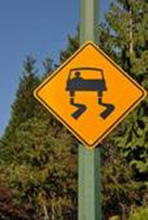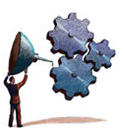Momentum
 Momentum is the force of a moving object. The momentum of an object is proportional to its weight and speed.
Momentum is the force of a moving object. The momentum of an object is proportional to its weight and speed.
- When you are driving, both you and your vehicle have acquired momentum, which is proportional to the weight of your vehicle and its speed.
- If you increase your speed from 10 MPH to 20 MPH, you double your car’s momentum.
- If you increase your speed from 10 MPH to 50 MPH, you increase your car’s momentum five times.
- When you make a controlled stop, the momentum of your vehicle must be overcome by:
- The friction force of your brakes
- The friction force between your tires and the road
- The compression force of your engine.
- When you are in a crash, the momentum and kinetic energy of your vehicle and body must be absorbed. This results in heat, deformation of your vehicle and possible injury to your body.
Friction
Friction is a force caused by the contact of one surface on another. It results in the resistance of an object moving over a surface.
Friction is:
- Increased by the weight of your vehicle
- Decreased if your tires are over-inflated or are worn smooth
- Increased if your tires are under-inflated
- Affected by the material used to construct the road
- Affected by the condition of the surface of the road (including factors due to weather)
Friction occurs:
- Between your tires and the road
- In your brakes when applied
- In many parts of your engine and transmission (including the clutch, when engaged)
Friction Effects on Stopping
- Because friction is increased by the weight of your vehicle, a fully loaded truck has more stopping power than does an empty one because it is heavier.
- The weight helps in stopping the vehicle by producing more friction between the tires and the road surface.
- The kinetic energy of your moving vehicle is converted into heat during braking because of the friction of your brakes against your wheels and the friction of your tires against the road.
Friction Effects of Roads and Tires
Worn or over-inflated tires will reduce the friction between your tires and the road surface. This results in the reduction of traction needed to:
to:
- Start smoothly
- Stop quickly
- Pull out of a turn or curve without losing control.
Changes on the road surface due to the following could result in your losing control of your vehicle:
- Ice
- Rain
- Snow
- Oil
- Diesel fuel buildup
- Sand or dirt.
Friction Effects on Braking
- The kinetic energy of your vehicle cannot be converted into friction in your brakes (heat energy) when your brakes are locked as they are in a locked-wheel skid.
- If the components of your brakes become too hot, they cannot release any more heat and will fail to absorb any more kinetic energy (such as when traveling down a steep hill and using your brakes a lot).
- The purpose of anti-lock brakes is to prevent your wheels from locking during a quick stop so that your brakes can continue to absorb energy and you can maintain traction.
- The loss of traction in a stop or turn can be avoided by:
- Driving slower
- Properly using your brakes
Skidding while braking is caused by the friction of your brakes being stronger than the friction force between your tires and the road. This occurrence causes you to lose traction.
occurrence causes you to lose traction.
Friction Effects on Vehicle Components
- The friction that the clutch creates when released can:
- Cause loss of traction if released improperly (peeling out)
- Slow your vehicle down by engaging a lower gear
- Allow the vehicle to move regularly.
- The friction on your brakes and clutch results in brake and clutch wear.
- If used improperly, excessive wear to the brake pads and clutch can occur.
- To avoid this:
- Do not ride your brakes
- Do not drive with your clutch partially engaged (depressed)
- Use your lower gears to slow the vehicle on downhill grades (downshift). Improper lubrication of your engine and transmission will cause excessive friction, which will result in mechanical failure.


